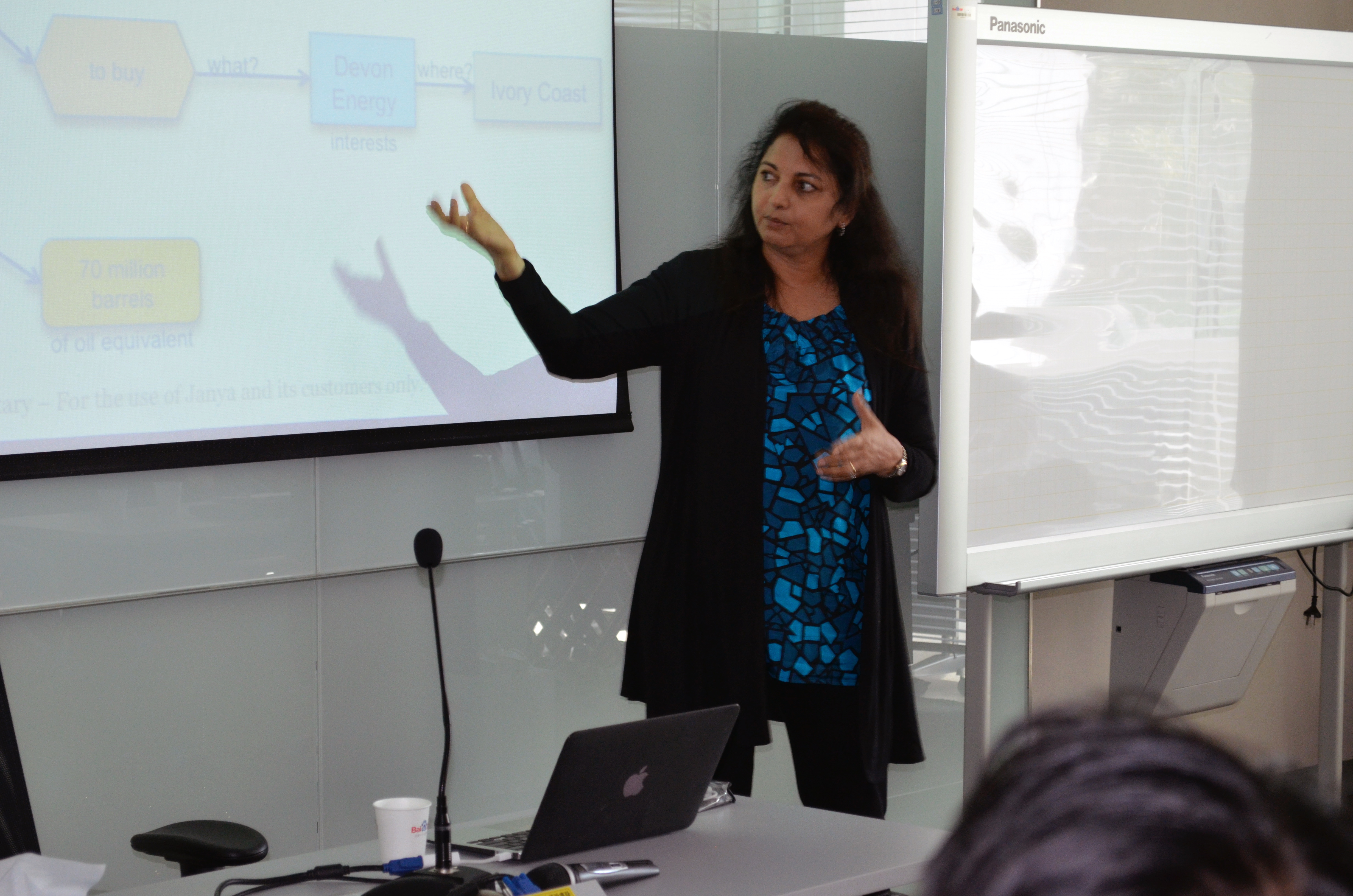Peace Tech is Good for Business

“We can spot stories before they become stories.”
How did groundTruth come to exist?
groundTruth was created to help meet the global demand that exists for many of the scalable solutions we are developing in the peacebuilding technology sector—especially early warning systems. It’s a combination of things–the need for scalable solutions, the opportunity to leverage a lot of data that’s now available, and the recognition that these kinds of solutions, particularly those involving early warning, not only provide value to the peacebuilding and global aid communities, but also to the private sector. Multinational corporations are all looking for this type of advanced warning against disruptions in emerging countries. We thought that groundTruth would be a great platform to launch and to serve many different types of stakeholders. That is how groundTruth was born.
What types of data does groundTruth monitor?
When it comes to data, we look at everything. We look at a lot of the traditional big data sources. We look at social media, we look at news, we look at sensor data. There is some really interesting sensor data available. You can measure soil moisture to give advanced warning for pocket draughts. You can measure air quality. You can even use audio sensors that detect gunshots, or that detect deforestation. It’s amazing what’s being developed in sensors and satellite imagery. We also look at event databases, where they’re reporting on conflict events, like ACLED and so on.
The data source we are particularly excited about is what we call ‘local data.’ This is data that is actually sourced locally, from trusted networks such as people, local peacebuilders, and similar contacts. The goal is eventually to crowdsource this local information. You can get some information, actually quite a bit of information, from publicly available data. However, for some specific data sources and peoples’ perceptions of what’s happening there and what could happen, it’s best to source that locally.
groundTruth combines human and machine intelligence. Why is it important to utilize both for risk management?
Solutions for risk assessment, management, and mitigation involve monitoring literally hundreds of cities globally 24/7. For that alone, you need some automated methods. We can do round-the-clock monitoring for any place on the globe, and the machine intelligence allows us to monitor in a passive way, but also to actively monitor. Machine intelligence is really good for tasks where you aggregate data and you do things like predictions, or quantification. All of those kinds of tasks that machine learning systems are good at handling. But, you also need to complement that with human expertise.
Maybe, you can make a prediction that something is going to happen. You can even say why, and all of that can be automated. If you have a human expert, they can tell you the potential impact of that event with the context, and really provide insight–plus mitigation strategies. This what conflict experts deal with, they’ve seen similar situations, and they can provide that insight. This is really where groundTruth tries to leverage the best of both human and machine intelligence.
“I’ve heard an executive from a very large multinational beverage company say that ‘Peace is good for business.’”
What are some trends you’ve noticed through groundTruth?
We like to say that, “We can spot stories before they become stories.” We’re projecting things like likelihood of protests—some of which are violent—down to the city and date. That’s what we’re actually doing in terms of our projections. We monitor data, and we can see some trends and say, “Hey, this might turn into some big story.”
An example of that is the migrant flow of refugees from Venezuela to Colombia. This started hitting the major newspapers probably around February to March 2018, when it started becoming a big story. At groundTruth, we actually started observing this trend back in May of 2017. We started picking up some stories but didn’t see it as a big trend at that point. A few months later, we noticed that this story kept persisting and by January, we were seeing that it was really trending. Even though it didn’t start hitting the news until later, we actually started picking up that this could be a big story. Those are the kinds of things that groundTruth can spot.
What kinds of forecasts can we derive from those trends?
Right now, we are forecasting different types of disruptions. We are actually predicting protests, riots, and strikes. We can say with 80% probability that there’s going to be a major incident in this city, on this date. As groundTruth operates more and more, it accumulates more data. Our goal is to say that we predict that maybe this week, with an 80% chance or whatever it may be, your organization, your business, is going to face some sort of disruption to their operations–whether it’s manufacturing, distribution, transportation, safety, etc. That’s what we’re really looking at, being able to predict those kinds of disruptions.
Will this technology encourage businesses to invest in regions that might be considered too risky due to instability or other factors?
Absolutely, yes. In fact, I’ve heard an executive from a very large multinational beverage company say that “Peace is good for business.” The reason being is that these companies are always looking to open new markets for their products and services. It’s in their interest to actually go into some areas that still have volatility. I’m not talking about extreme conflict zones, but areas where there is still quite a bit of volatility. That’s where groundTruth really comes in, because your company, your organization, may want to operate there. You know that there are risks there, but you also see plenty of opportunities. For that, you need some sort of a risk assessment 24 by 7–a risk monitoring solution that sort of gives you that peace of mind. So yes, absolutely, there’s tremendous incentive.
“Having this solution gives so many things.”
There is a lot of focus on negative risks, but this technology can be used to identify opportunities as well.
We talk about conflict and risk and so on, but in the peacebuilding community, they also look for indicators of resilience. What kind of signs, what kind of data can we gather, to come up with not only a risk index, but also a resilience index indicating that things are improving or becoming much more stable? One of the things we’re doing with groundTruth is producing a weekly index at the city level. Then, we look at various kinds of risk factors, whether it’s infrastructure, crime, environment, and so on. Based on data, on a weekly basis, we update this index so you can see the trends. That really is very useful for companies to do ongoing risk assessments.
“Is this a city that I should still continue doing business in? Maybe this is a new opportunity for us to open a branch here.” They [companies] need that constant information. Right now, what they’re doing is hiring maybe consulting companies to give them a report. Those are very expensive, and also probably out of date as soon as they give it to you. This is what we are providing, an ongoing risk assessment, monitoring, based on real-time data.
Where do you see this technology moving in the next 5 years?
I see us using a lot more data sources. First of all, the coverage, we’d want to have global coverage. Right now, we’re looking at emerging countries. We’d also want to start looking at very fragile conflict zones as well. One thing is coverage, and the granularity of coverage. We’re looking at cities, going from 25, to 50, to 100 cities at least, or more. That is an area of expansion. I also foresee a lot more data sources that we will be able to ingest and aggregate–doing a much better job of predictions.
My vision for this, the way I express it is, on Wall Street, anyone who works on Wall Street or in the investment community, they have Bloomberg Terminals on their desks which give constant visibility into the markets and what they should be doing. I view groundTruth as something like that for people who are working in international operations, development, aid, peacebuilding. All of them should have a groundTruth monitor on their desk which gives them that real-time visibility into what’s going on to allow them to make decisions. That’s the goal.
One other thing I wanted to mention is that for a solution like groundTruth to be really successful, it involves a real public-private partnership. We’re offering the solution–but, in order to reach those scales we want to attain by having data collection at a local level all over the globe, we need to work with private partners. Large companies are interested in engaging with the communities in which they actually operate, and that’s a good trend. Maybe, these are companies who might be interested in something that monitors pollution levels in particular cities. They could sponsor data collection around that. Other companies might sponsor data collection around deforestation and other issues. I think it’s the partnerships that are really going to make this succeed.
How do you envision the ways this technology will impact decision-making in the future?
Having this solution gives so many things. It gives you real-time visibility about what’s going on, also predictions–projections as to what might happen in the next few days, next weeks, and next months. It’s important to have different time predictions because some people are only focused on immediate safety and security. For safety in traveling, you might hear, “If you’re traveling for the next 24 hours, be careful.” We are looking at slightly different time windows. We are looking at, “OK, two days from now, we think there is going to be a major protest riot.”
If you are looking at supply chain types of issues–for them [companies], they need probably at least eight weeks, maybe three or four months, in order to make decisions around it. If I tell you, “There’s going to be a supply chain issue in two or three days from now,” that’s not enough time to react. That is why we are looking at different time horizons for the predictions. What we are really trying to do is provide people with decision support. They can only have that if we are able to give predictions well in advance, as well as the index and historical trends. Then, you can see the patterns and maybe decide, “Wow, things are getting much worse, we should pull out.” Or, “Things seem to be really improving, maybe this is a place where I want to expand operations.” There is a lot of possibility there.
“We need more Mozart’s and Da Vinci’s… technology might be helpful in that regard.”
What most concerns you about the world today? What gives you hope?
One thing that concerns me is that everything is moving at a much faster pace, largely due to technology and social media, and these kinds of things. Because of that, there’s hardly any time to absorb information. You hear something and immediately people are called on to provide a reaction. You know, it just happened within ten minutes, and you have to react to it. I think this problem is going to escalate. Not only that, I think it exacerbates tension and possibly leads to conflict. Everything is happening so fast due to technology. Sometimes, people need a little bit of time to digest the information, think about the implications, then make decisions. Everything is moving very fast these days, at such an accelerated pace. That is something that worries me.
On the flip side, what gives me hope, and this is my observation, I work in AI and machine learning and what I noticed while working both as a researcher and in industry–until now, this very advanced technology has been used most effectively by marketing people. Whether it’s for hyper-targeting people for ads, or for political persuasion, or whatever. Marketing is what it’s being used for–selling products online or recommending better movies. All of this great technology, and that’s what it’s primarily being used for. I really feel that this is the time and opportunity to leverage all of that technology for social good, for peacebuilding, for reducing conflict. Even to address societal issues, like how people who lose their jobs to automation can actually find other ways of earning a decent wage. Whether it’s being data sensors, everyone can contribute in some way, if we leverage technology correctly. Then, that frees them up to be creative again. We need more Mozart’s and Da Vinci’s. I think technology might be helpful in that regard.
This is a unique opportunity to really build a solution. Many things need to come together to offer a solution–availability of data, the penetration of mobiles, devices, internet in emerging countries, as well as companies and organizations who want to get into these markets. All of this has converged to create the opportunity. I hope we can attract more people who have computer science or data science types of training into this world of peacebuilding. I wish there was a way of incentivizing them to come and join these types of organizations.
Rohini Srihari is the Chief Data Scientist at Peacetech where she manages all the data and technology-related programs. She is responsible for overseeing Peacetech’s data and analytics hub which is used by peace builders around the globe to rapidly configure solutions for their specific needs. She brings her expertise as an educator, scientist and entrepreneur to Peacetech where she manages the development of innovative artificial intelligence solutions involving content such as social media, satellite imagery, and data obtained through trusted, local networks.
As a professor of Computer Science at the University at Buffalo, her research in text and data mining has been funded by agencies such as DARPA and the National Science Foundation as well as corporations. Her work incorporates multiple disciplines, including natural language processing, machine learning, multilingual text mining, and information retrieval. She has published extensively, given invited talks, and has supervised PhD, MS and undergraduate students. She has been involved in efforts to increase the participation of women and minorities in STEM disciplines.
As an entrepreneur, she has had experience in raising venture funding, developing and marketing software products, as well as overall responsibility for running a company. She founded Content Savvy, a company offering “big data” analytics for various markets, including healthcare, marketing and customer support; Content Savvy has since been acquired. Dr. Srihari serves as an advisor to organizations ranging from start-ups to non-profits.
Rohini received her undergraduate degree in Math and Computer Science from the University of Waterloo, Canada and her PhD in Computer Science from the State University of New York at Buffalo.




Got something to say?